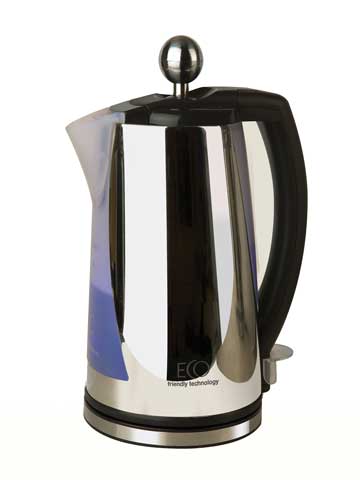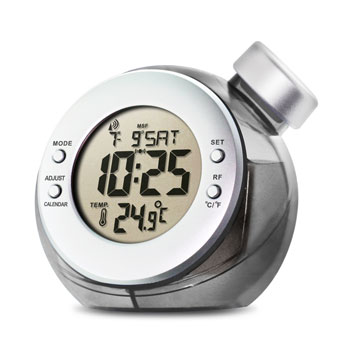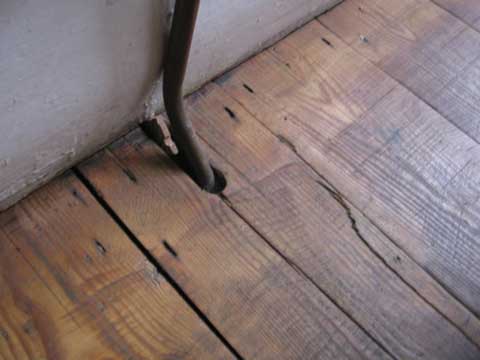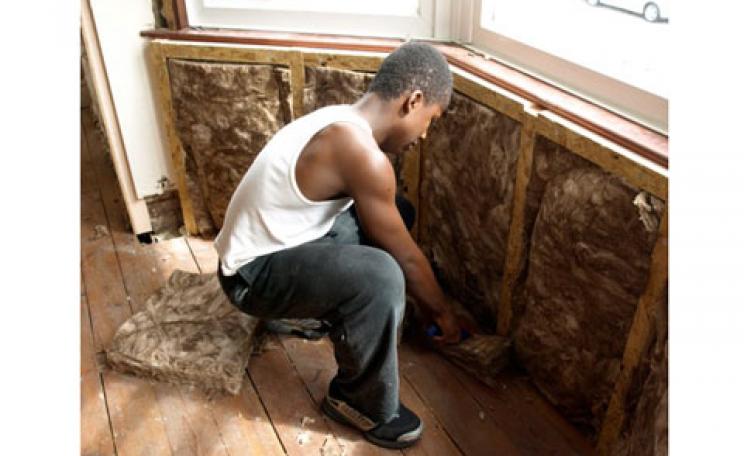A solar garden light used as a night light
Since I've started my ecorefurb I've been obsessively using an electricity monitor, which, with zero DIY or gadgetry set-up skills shows you how much energy you're using, what it's costing you now or over a period of time, and how much CO2 you're producing. Mine even tells me the temperature. Some electricity companies are giving them out, though if you need to buy one I've found the Owl monitor is good, especially as you can use it on batteries and carry it around the house with you while you compulsively monitor every aspect of your life (I was amazed to realise, for instance, that even the gas condensing boiler uses electricity every time it fires up - so there goes my theory about being OK for hot water when/if the much-touted electricity crisis comes).
Having the fridge, freezer, cooker, TV, PlayStation and a few energy-efficient lights on around the house accounts for a good couple of kilowatts, but even combined can't compete with the most energy-hungry gadget in the house - the kettle - closely followed by the cooker while on fast heat-up. Put the kettle on and our energy use shoots up by a massive 3.5kW. Admittedly a kettle's only guzzling electricity for a short time, but endless cups of tea all mount up, I reckon.
 Our kettle was pretty mangey so I decided to upgrade to an Eco Kettle from Nigel's Eco Store, which only uses 2.2kW. It's an ingenious design with two chambers: you decant water from the storage chamber to the boiling chamber by pushing down a plunger knob on the lid, so you only boil as much as you need and can see clearly on the gauge how full it is. It also looks quite funky, with a cool blue 'on' light that shines through the water. Similarly you can get energy-efficient toasters, irons and hairdryers. Obviously, all these things only need buying if your old ones have had it, otherwise the carbon footprint of producing, packaging and transporting the new ecogadgets is probably bigger than what you save by using them.
Our kettle was pretty mangey so I decided to upgrade to an Eco Kettle from Nigel's Eco Store, which only uses 2.2kW. It's an ingenious design with two chambers: you decant water from the storage chamber to the boiling chamber by pushing down a plunger knob on the lid, so you only boil as much as you need and can see clearly on the gauge how full it is. It also looks quite funky, with a cool blue 'on' light that shines through the water. Similarly you can get energy-efficient toasters, irons and hairdryers. Obviously, all these things only need buying if your old ones have had it, otherwise the carbon footprint of producing, packaging and transporting the new ecogadgets is probably bigger than what you save by using them.
Roaming around sites such as www.nigelsecostore.com, www.ecogadget.com, www.biggreensmile.com, www.windtrap.co.uk and www.easygreenstore.co.uk, I've realised that there's a whole ecogadget industry out there, which is both exciting and worrying in equal measure. I've had a wind-up radio for years, but always reverted to the batteries because, to be frank, getting out of bed is hard enough without having to spend several minutes doing a radio-winding workout every morning.
So here's my pick of ecogadgets good and not so good that I've come across in the quest to make my household low energy:
PowerSaver plug extension strip
Verdict: good if you're forgetful/lazy/have a busy family life
This device allows you to switch off individual appliances from a remote, avoiding standby. Obviously it is quite easy to walk the two-and-a-half feet to the wall socket if you're older than about five, but do we?
Solar garden lamps
Verdict: lovely in the garden, and some are good indoors too
Solar garden lamps are less harsh than typical outside lights, and you don't come back to them after several days kicking yourself that you forgot to switch them off. We've ended up using ours as a night light, as it lifts easily off the stand and this particular model casts a good wide light on the landing. There's a whole load of useful solar outside lights, and I've got my eye on some solar outdoor fairy lights for when our refurb is finished, to give it that super-eco-magic.
 Water-powered alarm clock
Water-powered alarm clock
Verdict: why on earth not?
Having an electric clock permanently plugged in when I only look at it for a few minutes a day seems the ultimate eco-silliness, but a water-powered alarm clock is totally carbon-free energy-wise. The only problem is that it doesn't have a light, so is no good as a bedside clock without a torch (probably not a wind-up one).
Ecobutton
Verdict: good for PCs but not always necessary
Ecobutton powers down your computer when you wander off to fetch something and then end up not coming back for three hours. I realised I'd set my laptop to do that automatically anyway, however, and if I put the lid down it does it immediately. If you have a standalone computer it's definitely a good idea, though - apparently a computer monitor left on standby can cost you £30 a year - and it's certainly something that should be standard on all office computers.
 Energy Wizard
Energy Wizard
Verdict: a leap of faith, but if you use the washing machine/washing up machine a lot it could be worth it
Plug the Energy Wizard into any spare plug in your house and the company says it can save 10 per cent of your energy as it reduces the difference between the times at which the voltage and current peaks occur. I asked an engineer to have a look into it and they suggested that it works as a capacitor, marginally improving the amount of power available to anything running on a motor, like washing machines (not lights). Although there's really no way I can monitor whether it does save me energy or not I figure it doesn't do any harm to have it plugged into a spare plug and hope.
Everyday household gadgets
Verdict: go for A+ but think outside the box
It's easy to get carried away with ecogadgetry that tinkers around at the edges of your energy consumption, while forgetting the big, everyday things.
The trend is on for flatscreen TVs, but plasma TVs (the larger ones) are much more energy-hungry than LCD TVs and massively more so than old-style cathode-ray TVs. We did change ours last year but went for the most energy-efficient LCD we could find.
We tend to use the washing machine every other day, and having an A+ rated one is probably the best ecogadget purchase we've made (more info on energy ratings is available from the Energy Saving Trust). I have realised though that it uses a cold-water feed, which it heats up, and if we were to get solar thermal panels (providing free hot water) it would make sense to have bought a model that could use the solar hot water instead.
When we upgraded our heating from an old gas boiler to a more energy-efficient condensing boiler we also shot ourselves in the foot a bit, as condensing boilers often aren't able to link up to solar thermal panel systems (some can, so check with the manufacturer). And we would need to buy a hot water tank for the water storage, having just had one expensively removed. So where all that leaves me I'm not sure, except a bit annoyed.
This week we were faced with the ultimate ecogadget quandary: our dishwasher packed up. We hardly used it anyway as it was old and pretty useless, but should we get one of those lovely, slim, shiny, A+ energy-rated machines? Or just stick with the good old washing-up bowl? My husband has printed out the Which? dishwasher pages already, which tell us that new dishwashers can use less water than washing up by hand and just 0.97kWh (costing 12.1p per wash), but it does go against my rather purist eco-grain. Of course, if we do get solar PV panels (for electricity) I only need to feel bad about the energy it took to make and transport the machine, so maybe we'll keep a space for it...
Blanket cooking
Verdict: ingenious
My top ecogadget tip, though, involves something we all have already: blankets. If you want to have a lovely casserole waiting for you when you get home, you could set the timer on your oven in the morning and leave it to use several hours' worth of energy, or you could get some blankets and use none. Make your casserole however you like (fish, chopped meat, veg, whatever), get it nice and hot, and put a lid on it. Get some blankets (two or three) and open them out on top of each other with a large towel as the top layer. Put them on top of a pillow on your kitchen surface or on a padded seat such as an armchair. Now wrap the pan up tightly - towel first, in case you've got any sauce on the edge of the pan - and then the blankets. Add more blankets if you can still feel the heat of the pan. Using the trapped heat, the casserole slow-cooks without burning or any mess. Go out (or stay in, even) and by the evening your dinner is ready and still hot enough to eat.
It's so good even the Owl monitor doesn't register it - and it doesn't cost you a thing.
For low-cost DIY instructions on almost any ecogadget you can think of (and more), check out www.instructables.com
Sue Wheat is a freelance journalist
| READ MORE... | |
 |
GREEN LIVING Turning our Victorian terrace into an ecohome: part three - floors Insulating the floor can be fiddly, messy and costly. Luckily, there are simple, cheap options too as Sue discovers |
 |
GREEN LIVING Turning our Victorian terrace into an ecohome: part two - insulation Sue has a brief love affair with solar panels, but realises that if she shies away from the thorny issue of solid wall insulation, she's throwing good money after bad |
 |
GREEN LIVING Turning our Victorian terrace into an ecohome: part one One family's journey to turn a draughty, turn-of-the-century terrace into a snug paragon of eco efficiency |
 |
INTERVIEW LSE's Anne Power: my recipe for 80 per cent energy savings in your home Anne Power, Professor of Social Policy Housing and Social Exclusion at the London School of Economics, on why nearly all homeowners can afford to insulate properly, and how to save energy on a budget |
 |
SPECIAL CONTENT Ecologist guide to greening your home Greening your home can save you energy and money as well as making it healthier and lowering its carbon footprint |







